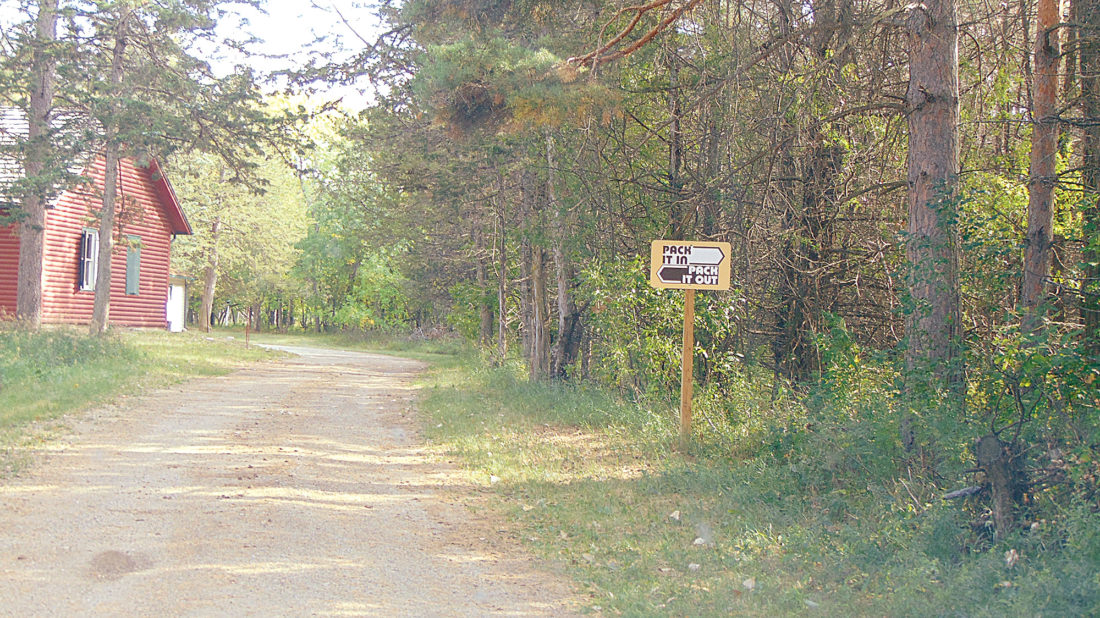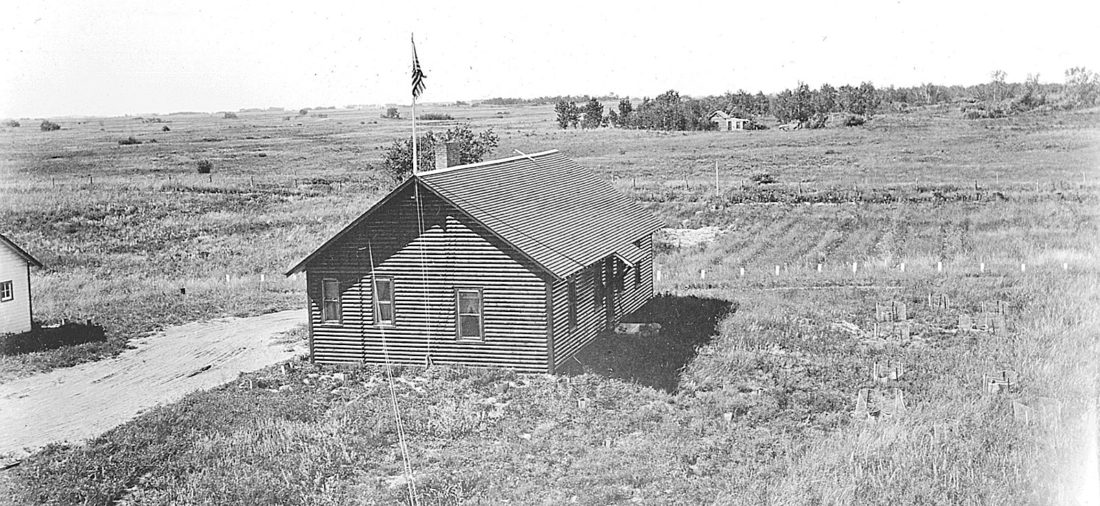Discovering Denbigh
Forest has long, important history in region

The red ranger cabin, built when the Denbigh Experimental Forest was established, stands in the shade of tall trees.
Drivers heading down U.S. Highway 2 can get used to the straight, smooth roadway before them, especially in summer. Comfortable cars make it easy to focus on their destinations ahead, and ignore the signs and stories the gravel roads intersecting the highway have to tell.
Ten miles west of Towner, pasture, cropland and occasional grassy slopes begin to disappear behind groves of pine, birch and box elder trees. A brown sign points out a wildlife viewing area, and just behind it, a green sign reads, “Denbigh Experimental Forest.”
A left turn down the short gravel road to this hidden bit of North Dakota history is well worth the detour.
About 1/10 mile south of Highway 2, a sign at the junction of another gravel road reads, “Dakota Prairie Grasslands National Park.” Small pinecones litter the ground, reminding folks who’ve traveled to other parts of the United States of South Dakota’s Black Hills, or the forests of the Rocky Mountains. But the smell of a cow pasture can hang in the air, too, and bring visitors back to reality: this forest is in the middle of North Dakota farm country.
At the National Park entrance, a red cabin and two white storage/shop buildings stand in the same place they were built to shelter and supply forest workers 87 years ago.

A 1932 photo of the same cabin, surrounded by treeless prairie.
Beyond the buildings, a message board maps out several trails for hiking, and informs visitors that trails in the forest are off-limits to motorized vehicles. One road that is accessible seems fit only for cars or trucks with 4 wheel drive, and at a slow speed, as prickly vegetation between wheel ruts can scrape and scratch against undercarriages.
In dry spells, the soil on the wheel tracks is soft, loose, and sandy, hinting at one reason why Denbigh Experimental forest was planted.
Casey Johnson, acting resources staff officer for the United States Forest Service, is based in Lisbon, and heads up the Dakota Prairie Grasslands, which includes the Denbigh Experimental Forest.
“It’s a completely different area than what you would expect on the Great Plains,” Johnson said of the forest. “You go from open prairie to this extremely mature forest, so I was quite surprised that it was as extensive as it is.”
“I grew up in Western Montana, so I’m used to forests,” Johnson continued. “When I got there, I was struck by how extensive the effort must’ve been to get it to where it is today. And then also, I was keenly interested in the character of the buildings. They really liken themselves to a time capsule going back into when they were constructed. Just the architecture and type of materials used have been very well preserved. “
“The Denbigh Experimental Forest was started in 1931-32, that’s when the buildings out there were constructed. And basically, what happened was, in 1931, Congress appropriated funds for the Denbigh Station. They appropriated $15,000 to get things going. The initial purpose of Denbigh was to establish an experimental station to identify how trees could be propagated in that part of North Dakota, and to support the creation of a forest in McHenry County,” Johnson said.
Forests in the Great Plains weren’t a new idea for North Dakotans even in the 1930s, however.
Author Thomas Turck described efforts by settlers to plant trees on the prairie in his book, Denbigh Experimental Station and Experimental Forest: Soil Conservation in the Plains States.
Turck noted the 1873 Timber Culture Act offered North Dakota homesteaders an additional 160 acres if trees were planted on a portion of their land. 8,000 settlers took advantage of the act, gaining title to 1.2 million acres through the act.
More efforts at forestation included a program to plant trees in Nebraska’s Sand Hill country in the late 1890s, which Turck wrote seemed a failure until maturing trees were found a decade after the original forest plot was abandoned.
Turck wrote that projects such as those in Nebraska inspired North Dakota to launch similar attempts to plant forests, and the North Dakota Agricultural Experiment Station, which included forestry, was established in Fargo in 1890. As forestry research continued, Turck said concerns over a need for forest products developed. Some researchers theorized using land as forests, rather than for grazing, would result in higher economic returns. The State School of Forestry at Bottineau was established in 1906, and the North Dakota State Forest Service operates from that site today. In 1912, The Northern Great Plains Research Laboratory opened in Mandan to continue the effort to establish forests in North Dakota.
Then, in the late 1920s and early 1930s, hard times struck farmers.
Archived issues of the Pierce County Tribune documented farm foreclosures in their legal pages, and Tribune issues from the summer of 1931 alluded to crop failures. A June 23, 1931, Tribune article read, “The rain on Sunday morning did not amount to much, altho (sic) it helped to settle the dust, and the change in the weather helped some.”
An article published in the Tribune the week before lamented, “For the texture of the soil and the amount of rainfall over North Dakota, the common tendency is to plow the ground too much and too deep.”
Rugby resident Nick Schall grew up on his family’s farm in western Pierce County, south of Berwick in the 1930s.
“We’d wake up in the morning, and there was dust a half inch high on the windowsills. We were supposed to go and get the cows, but we couldn’t see them,” Schall recalled. “And we walked, and pretty soon, here they are. And their eyes were covered with dirt, and they could hardly see. It was all the way down their cheeks. Just dirt… That lasted two years at least.”
Meanwhile, plans to devote land in North Dakota to forests continued. The Denbigh Experimental Station was home to an expanding number of seedlings, and a nursery was established in Towner to supply a proposed Souris National Forest.
Johnson explained, “The initial emphasis was on that creation of that forest, and (the land) was looked at in terms of everywhere from 200,000 to 480,000 acres in size, lying along and near the Souris River. That (proposal) was approved by Congress, but funding never came.”
“So, as you go through time, you get to this place where the funds never came, and other things started occurring, and building steam with regards to the Dust Bowl. If you had to look back through history, Black Sunday on the 14th of April 1935 was kind of that tipping point as far as the nation’s awareness as far as what was going on, with regards to wind erosion, and the compounding effects of that on top of the Great Depression. So, at that point, the focus of the Denbigh Experimental Station (which is what it was called originally), and the nursery shifted from this concept of a broad national forest to supporting the efforts around the Shelterbelt Project, the New Deal, and the Prairie States Forestry Project,” Johnson continued.
As the Denbigh Experimental Forest changed its focus, so did the State Nursery at Towner, which now uses the forest as a source for seedlings, which supply trees to North Dakota.
“I don’t know if some folks realize what the (forest’s) original purpose was, but when it shifted, the original work that was done out at Denbigh from (researchers) like Dr. Carlos Bates and Dr. Joseph Stoeckler really generated a lot of information through their research to support the establishment of shelter belts on the Great Plains,” Johnson indicated.
“We’ve got some of the original handwritten journals here in Lisbon at the District Office, and it’s amazing how meticulous those folks were, looking at the different variables they were up against, and the different challenges of growing trees on the treeless plains, prairie, especially when you have conditions that were fairly tough for anything, let alone getting trees going.”
Early photos of Denbigh’s red ranger cabin show Dr. Stoeckler and his wife sitting on the steps, surrounded by treeless, sandy grassland. Visitors to the cabin today will have a difficult time imagining the scene, as spruce and pine trees tower overhead.
“All (the buildings) are still there, in very good condition,” said Johnson. “They’re actually on the National Register of History Places, so that’s recognized and so, we’ve done our best to maintain them in their original condition and character. And we’ve been very successful at that.”
Since Denbigh Experimental Forest became a part of the Dakota Prairie Grasslands in 1998, its purpose has shifted again, this time, to conservation, education and recreation.
Johnson observed, “In regards to conservation, I think as we move through time, we witnessed incidents in our past when we’ve had to respond to challenges and it’s always wise to learn from our past and learn new ways of improving conservation on public lands, and for natural resources in general.”
“We’ve got a lot of opportunities for recreation out there, from hiking on just above three miles of trails, to bird watching, or wildlife viewing,” he continued. “That’s one thing that happens when you put a forest in the middle of the prairie. It does attract a lot of different species (of animals).”
The Denbigh Experimental forest will host area schools Friday, Sept. 28, for Denbigh Day, an annual opportunity for learning and interaction with nature. At 6 p.m. that evening, the park will open to the public, Johnson said.
“At 6, the public will have the opportunity to come out, and we’ll have S’mores (provided), and folks can bring their own meals. And I’ll be talking about the history of Denbigh, and then, we have a hike on the Skyline Trail if folks want to go experience that,” Johnson noted. “Then, we have Deb Nelson, – she’s the high school science teacher in Bottineau – who will be doing a constellation presentation, starting at 8:30 p.m., depending on when it gets dark enough to see the stars.”
Both Johnson and Treva Slaughter, Public Affairs Officer for Dakota Prairie Grassland, encourage the public to visit the evening of Denbigh Day, or any day the park is open.
“I try to encourage people when they come into the office, I talk about Denbigh, and most North Dakotans don’t know it’s there,” Slaughter said. ” I always try to encourage them, if they get a chance, to go up and check it out, because it’s pretty interesting.”


